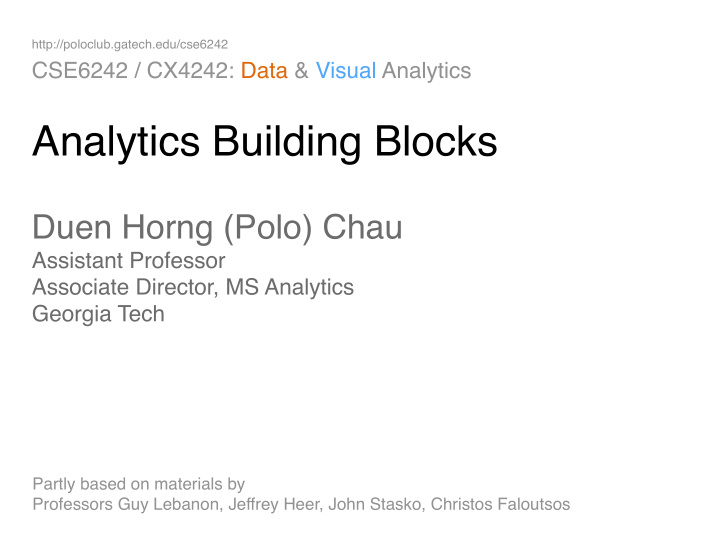



http://poloclub.gatech.edu/cse6242 CSE6242 / CX4242: Data & Visual Analytics Analytics Building Blocks Duen Horng (Polo) Chau Assistant Professor Associate Director, MS Analytics Georgia Tech Partly based on materials by Professors Guy Lebanon, Jeffrey Heer, John Stasko, Christos Faloutsos
Collection Cleaning Integration Analysis Visualization Presentation Dissemination
Building blocks, not “steps” Collection Can skip some Cleaning Can go back (two-way street) Examples Integration • Data types inform visualization design Analysis • Data size informs choice of algorithms Visualization • Visualization motivates more data cleaning • Presentation Visualization challenges algorithm assumptions e.g., user finds that results don’t make sense Dissemination
How big data affects the process? The Vs of big data (used to be 3Vs, now 7Vs) Collection Volume : “billions”, “petabytes” are common Cleaning Velocity : think Twitter, fraud detection, etc. Integration Variety : text (webpages), video (youtube)… Analysis Veracity : uncertainty of data Variability Visualization Visualization Presentation Value Dissemination http://www.ibmbigdatahub.com/infographic/four-vs-big-data http://dataconomy.com/seven-vs-big-data/
Gartner's 2017 Hype Cycle (debatable) https://www.forbes.com/sites/louiscolumbus/2017/08/15/gartners-hype-cycle-for-emerging-technologies-2017-adds-5g-and-deep-learning-for-first-time/#3855c7405043 https://en.wikipedia.org/wiki/Hype_cycle
“Artificial Intelligence”
We’re in the 3rd wave of “AI” boom • Two “AI winters” before https://en.wikipedia.org/wiki/History_of_artificial_intelligence • We should be cautiously optimistic (Polo’s motto)
“Neither Autopilot nor the driver noticed the white side of the tractor trailer against a brightly lit sky, so the brake was not applied” https://www.tesla.com/en_GB/blog/tragic-loss?redirect=no
Good Read about AI: White House Report Preparing for The Future of Artificial Intelligence https://www.whitehouse.gov/sites/default/files/ whitehouse_files/microsites/ostp/NSTC/ preparing_for_the_future_of_ai.pdf
“The Current State of AI Remarkable progress has been made on what is known as Narrow AI , which addresses specific application areas such as playing strategic games, language translation, self-driving vehicles, and image recognition. Narrow AI underpins many commercial services such as trip planning, shopper recommendation systems, and ad targeting, and is finding important applications in medical diagnosis, education, and scientific research. These have all had significant societal benefits and have contributed to the economic vitality of the Nation.
General AI (sometimes called Artificial General Intelligence, or AGI) refers to a notional future AI system that exhibits apparently intelligent behavior at least as advanced as a person across the full range of cognitive tasks. A broad chasm seems to separate today’s Narrow AI from the much more difficult challenge of General AI. Attempts to reach General AI by expanding Narrow AI solutions have made little headway over many decades of research. The current consensus of the private-sector expert community, with which the NSTC Committee on Technology concurs, is that General AI will not be achieved for at least decades. ”
Likely no Matrix or SkyNet in Your Life Time
Schedule Collection Cleaning Integration Analysis Visualization Presentation Dissemination
Two Example Projects from Polo Club
Apolo Graph Exploration: Machine Learning + Visualization Apolo: Making Sense of Large Network Data by Combining Rich User Interaction and Machine Learning . Duen Horng (Polo) Chau, Aniket Kittur, Jason I. Hong, Christos Faloutsos. CHI 2011. 15
16
Beautiful Hairball Death Star Spaghetti 16
Finding More Relevant Nodes HCI Paper Data Mining Paper Citation network 17
Finding More Relevant Nodes HCI Paper Data Mining Paper Citation network 17
Finding More Relevant Nodes HCI Paper Data Mining Paper Citation network Apolo uses guilt-by-association (Belief Propagation) 17
Demo : Mapping the Sensemaking Literature Nodes : 80k papers from Google Scholar (node size: #citation) Edges : 150k citations 18
Key Ideas (Recap) Specify exemplars Find other relevant nodes (BP) 20
What did Apolo go through? Scrape Google Scholar. No API. 😪 Collection Cleaning Integration Design inference algorithm Analysis (Which nodes to show next?) Interactive visualization you just saw Visualization Paper, talks, lectures Presentation You may use a new Apolo prototype Dissemination (called Argo)
Apolo: Making Sense of Large Network Data by Combining Rich User Interaction and Machine Learning . Duen Horng (Polo) Chau, Aniket Kittur, Jason I. Hong, Christos Faloutsos. 22 ACM Conference on Human Factors in Computing Systems (CHI) 2011 . May 7-12, 2011.
NetProbe : Fraud Detection in Online Auction NetProbe: A Fast and Scalable System for Fraud Detection in Online Auction Networks. Shashank Pandit, Duen Horng (Polo) Chau, Samuel Wang, Christos Faloutsos. WWW 2007
NetProbe: The Problem Find bad sellers ( fraudsters ) on eBay who don’t deliver their items $$$ Buyer Seller Auction fraud is #3 online crime in 2010 source: www.ic3.gov 24
25
NetProbe: Key Ideas § Fraudsters fabricate their reputation by “trading” with their accomplices § Fake transactions form near bipartite cores § How to detect them? 26
NetProbe: Key Ideas Use Belief Propagation F A H Fraudster Darker means Accomplice more likely Honest 27
NetProbe: Main Results 28
29
29
“Belgian Police” 29
30
What did NetProbe go through? Scraping (built a “scraper”/“crawler”) Collection Cleaning Integration Design detection algorithm Analysis Visualization Paper, talks, lectures Presentation Not released Dissemination
NetProbe: A Fast and Scalable System for Fraud Detection in Online Auction Networks . Shashank Pandit, Duen Horng (Polo) Chau, Samuel Wang, Christos Faloutsos. International Conference on World Wide 32 Web (WWW) 2007 . May 8-12, 2007. Banff, Alberta, Canada. Pages 201-210.
Homework 1 (out next week; tasks subject to change) • Simple “End-to-end” analysis Collection • Collect data using Twitter API Cleaning • Store in SQLite database Integration • Great graph from data Analysis • Analyze, using SQL queries (e.g., Visualization create graph’s degree distribution) • Visualize graph using Gephi Presentation (and maybe Argo) Dissemination • Describe your discoveries
Recommend
More recommend